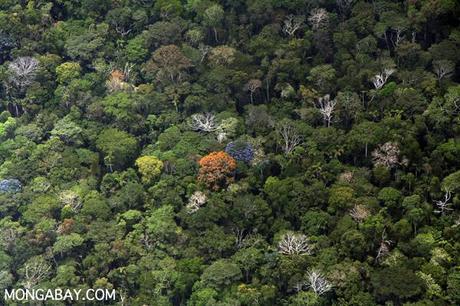
The Amazon rainforest. Photo by Rhett A. Butler
I know – ‘incentivise’ is one of those terrible wank words of business speak. But to be heard by the economically driven, one must learn their guttural and insensitive language. I digress …
Today’s post is merely a repost of an interview I did for the new Mongabay.com series ‘Next Big Idea in Forest Conservation‘. I’m honoured to have been selected for an interview along with the likes of Bill Laurance and Stuart Pimm.
Consider this my conservation selfie.
An Interview with Corey Bradshaw
Mongabay.com: What is your background?
Corey Bradshaw: I have a rather eclectic background in conservation ecology. I grew up in the wilds of western Canada, the son of a trapper. My childhood experiences initially gave me a primarily consumptive view of the environment from trapping, fishing and hunting, but I learned that without intact environmental functions, these precious resources quickly degrade or disappear. This ironic appreciation of natural processes would later lead me into academia and the pursuit of reducing the rate of the extinction crisis.
I completed my first degrees in ecology in Montréal and the University of Alberta, followed by a PhD in New Zealand at the University of Otago. After deciding to pursue the rest of my career in the Southern Hemisphere, I completed my postdoctoral fellowship at the University of Tasmania. Multiple field seasons in the subantarctic and Antarctica probably assisted in a giving me a burgeoning desire to change gears, so I left for the tropics of northern Australia to begin a position at Charles Darwin University. Being introduced there to conservation greats like Navjot Sodhi (sadly, now deceased), Barry Brook and David Bowman turned my research interests on their ear. I quickly became enamoured with quantitative conservation ecology, applying my skills in mathematics to the plight of the world’s ecosystems. Nowhere did the problems seem more intractable than in the tropics.
I am now based at the University of Adelaide (since 2008) and have a vibrant research lab where we apply our quantitative skills to everything from conservation ecology, climate change, energy provision, human population trends, ecosystem services, sustainable agriculture, human health, palaeoecology, carbon-based conservation initiatives and restoration techniques.
Mongabay.com: How long have you worked in tropical forest conservation and in what geographies? What is the focus of your work?
Corey Bradshaw: I tend to take a broad-scale approach to my work, so the tropics in particular represent just one part of my focus. My team and I use large species datasets to test hypotheses about general ecological trends and processes. My interest in tropical forests in particular is based on their superior biodiversity value, high threat and, perhaps ironically, their sensitivity to climate change. My real interest in the tropics began when I first moved to northern Australia in 2004. Spending time there and in Singapore working with Navjot Sodhi, I became interested in the desperate plight of tropical biotas after seeing first hand how quickly they were disappearing.
Mongabay.com: What do you see at the next big idea or emerging innovation in tropical forest conservation? And why?
Corey Bradshaw: It has become clear to me that nothing can replace primary vegetation, both in terms of biodiversity value and other ecosystem services (e.g., flood mitigation and carbon storage). While restoration is essential given the extent and rate of primary forest loss, we need financial mechanisms to guard what’s left. While certainly not ‘innovative’ in terms of concepts, there has yet to be designed a globally effective financial incentive to protect existing forests of sufficient magnitude and quality to preserve biodiversity. From my own work and that of colleagues, even protected areas are under siege and can by no means ensure biodiversity maintenance. I therefore see the most promising innovation in tweaking existing carbon-trading rules to value primary forest above all other forms of land use, effectively erasing the unfortunate requirement of ‘additionality’ (providing more carbon benefits than would have happened anyway without investment) for any carbon market-financed incentives. This would need to be done at the global level (e.g., Kyoto 2) as well as incorporated into the national markets of emerging and established economies, both in the tropics and elsewhere.
Mongabay.com: What are the primary obstacles to “tweaking existing carbon-trading rules to value primary forest”?
Corey Bradshaw: The ‘additionality’ requirement. [Also] ensuring that no ‘leakage’ occurs, and that the forests are maintained in permanence – these three [leakage, permanence and additionality] make up the unholy trinity of carbon-financed forest protection. See associated blog post Unholy trinity of leakage, permanence and additionality.
Mongabay.com: Are you personally involved in any projects or research that represent emerging innovation in tropical forest conservation?
Corey Bradshaw: I mentioned that we’ve established some pretty convincing evidence that nothing can replace primary forests, and I have done some preliminary work on improving the financial incentives for protecting them. I have also been involved in setting up some of the world’s first biodiversity-carbon restoration experiments, both in the tropics and temperate zones of Australia. I hope to be able to expand these projects to provide sound restoration advice to other regions, but of course, money is always the limiting component.
Read the original post here.

